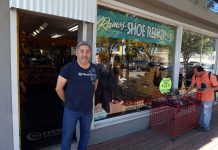On Healdsburg Avenue, reality is veering strangely close to
science fiction: patients are sliding into transparent, body-sized
capsules, and their chronic wounds are healing.
It’s not magic, of course, but medical technology at work.
Healdsburg District Hospital’s new Northern California Wound Care
facility is now offering hyperbaric oxygenation therapy for chronic
wounds.
“It’s 100 percent oxygen, and we double the pressure to twice
atmospheric,” said Medical Director Dan Rose, M.D. “It’s called the
dive. Patients are moved gradually through the process. It’s not
uncomfortable—I’ve done it,” he said. Rose noted that at any given
moment, one square foot of a person’s skin is already subjected to
one ton of air pressure, which is partly why the increase is
comfortable.
The process of increasing the pressure inside the chamber is
known as “the descent,” and the time spent at maximum pressure is
known as being “at depth.” The hyperbaric chamber utilizes scuba
diving terminology for good reason: the chambers were originally
used to treat divers who suffered from decompression sickness, or
the bends.
Doctors soon realized that hyperbaric chambers, like those on
Healdsburg Avenue, had other uses.
“The chamber gets so much oxygen in your blood that it dissolve
throughout the liquid in your body, and your cells become
hyperoxygenated,” Rose said. “It gives the tissues that were
otherwise not getting enough oxygen, enough oxygen. And it
stimulates the white blood cells to fight infection better.”
“The pressure also squeezes down the tissue so you don’t have as
much swelling,” he added.
The recommended course of treatment is 90 minutes in a
hyperbaric chamber, five days a week, for six weeks. It takes
approximately 15 minutes to descend, and 15 minutes to ascend, so
each treatment takes approximately two hours. With two chambers at
Northern California Wound Care, 8 patients can be treated per
day.
“For the community and the region, it’s a service that’s not
offered between the Oregon border and the city of San Francisco.
There’s one in Redding, but not in the coastal region,” said
Healdsburg District Hospital Chief Executive Officer Evan
Rayner.
“It’s a quality of life changer, as well as a life changer for
some folks, to now have an answer to healing chronic wounds. It not
only benefits the general population, but also those clients in the
veterans administration,” Rayner said.
Each year, approximately 12 million Americans suffer from
chronic wounds. The most common chronic wound is a diabetic ulcer
on the patient’s lower extremities. Six to seven percent of Sonoma
County residents suffer from diabetes, and 16 percent of residents
over 65 years old have the disease.
“It’s wonderful to have this facility in Sonoma County because
otherwise patients would have to go to San Francisco or the East
Bay,” Dan Rose noted. “And because people have to be treated Monday
through Friday for six weeks, it’s hard to travel far.”
Approximately one third of the patients treated with the new
hyperbaric chambers at Northern California Wound Care suffer from
diabetic ulcers, one third from bone infections, and one third from
conditions caused by radiation treatment. Radiation necrosis—the
death of healthy tissue—can afflict cancer patients who have been
treated with radiation. Osteoradio-necrosis of the jaw can occur,
and at-risk patients often undergo preventative hyperbaric
oxygenation therapy prior to having routine dental work done.
“For the hospital and the district this is another service that
is innovative and
also meets the need of the region,” Rayner said. “It will
complement other existing wound care facilities out there. None of
them offer hyperbaric oxygen therapy, so our treatment enhances the
quality of care for our patients.”








